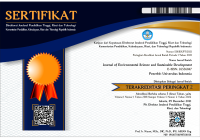Abstract
Global warming causes extreme weather and seawater levels to rise. Long-term climate change prediction has been done in various fields, including disaster management. It forced people to adapt to the consequences of climate change in coastal areas. Mitigation and adaptation are complementing each other in addressing climate change risks. Climate change mitigation supports essential aspects of sustainable development, specifically related to the UN Sustainable Development Goals on climate action (SDG13) and disaster risk reduction (SDG11). Making the community sustainable in a disaster is one of the ways to do this. Community sustainable development can be used to mitigate and adapt to climate change. This study aims to determine the potential of the community to become a sustainable community as an act of mitigation. The assessment in this research applies spatial statistics, which define spatial trends regionally by using the Z-score method to determine four equally essential indicators. Four indicators of a sustainable community are every sub-district's economic, social, environmental, and institutional conditions. The result shows that the Tanjungjaya sub-district has the most potential to be a sustainable community as it has high potential in economic, environmental, and institutional indicators. The lowest potential area is the Gombong sub- district. It has low potential in social, environmental, and institutional indicators. By knowing which indicators have higher values, sustainable community development in regions can be carried out by utilizing these indicators to improve other indicators. It can be concluded that the Tanjungjaya sub-district can lead the way to developing a sustainable community, followed by Mekarsari, Citeureup, Panimbangjaya, Mekarjaya, and Gombong sub-district. This research highlights future research should be done by reckoning this research method as a foundation for assessing sustainable development.
Recommended Citation
Hanifa, Syifa; Mardiatno, Djati; and Ruslanjari, Dina
(2024).
ASSESSMENT IN THE POTENTIAL OF SUSTAINABLE COMMUNITY DEVELOPMENT.
Journal of Environmental Science and Sustainable Development, 7(1), 444-459.
Available at: https://doi.org/10.7454/jessd.v7i1.1216






